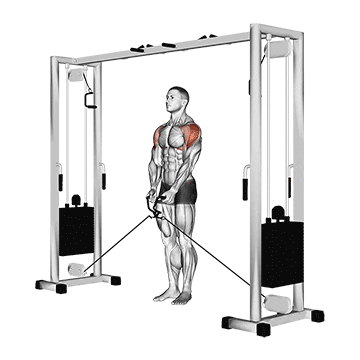The Cable Lateral Raise is an exercise that targets the deltoid muscles, specifically the lateral head of the shoulder. This exercise helps to improve shoulder strength and stability.
How to perform
To perform the Cable Lateral Raise:1. Start by setting the cable machine to the appropriate weight and attaching a single handle to the low cable pulley.
2. Stand facing the cable machine with your feet shoulder-width apart and knees slightly bent. Hold the handle in your hand with an overhand grip.
3. Engage your core and maintain good posture throughout the exercise, keeping your chest up and shoulders back.
4. Keeping a slight bend in your elbow, slowly lift the handle out to the side, away from your body, while maintaining a neutral wrist position.
5. Keep your arm straight as you raise the handle to shoulder height, parallel to the floor. Contract your deltoid muscle at the top of the movement.
6. Slowly lower the handle back to the starting position, being mindful not to let the weight pull your arm down too quickly.
7. Repeat for the desired number of repetitions, then switch sides and perform the exercise with the other arm.
8. Remember to control the movement throughout the exercise, focusing on using the shoulder muscles to lift the weight, rather than swinging or using momentum.
9. It's important to use proper form and technique to prevent injury and maximize the effectiveness of the exercise. If you experience any pain or discomfort, stop the exercise immediately.
10. Incorporate the Cable Lateral Raise into your shoulder workout routine to help build strength and definition in your deltoid muscles.
Equipment required
Cable
Cable equipment consists of adjustable pulleys attached to weight stacks that allow for resistance training. This equipment is commonly used for strength training exercises that target various muscle groups in the body, such as chest, back, arms, and legs. Cable equipment provides a versatile and functional way to perform exercises that mimic real-life movements, improving muscle endurance, stability, and coordination.


